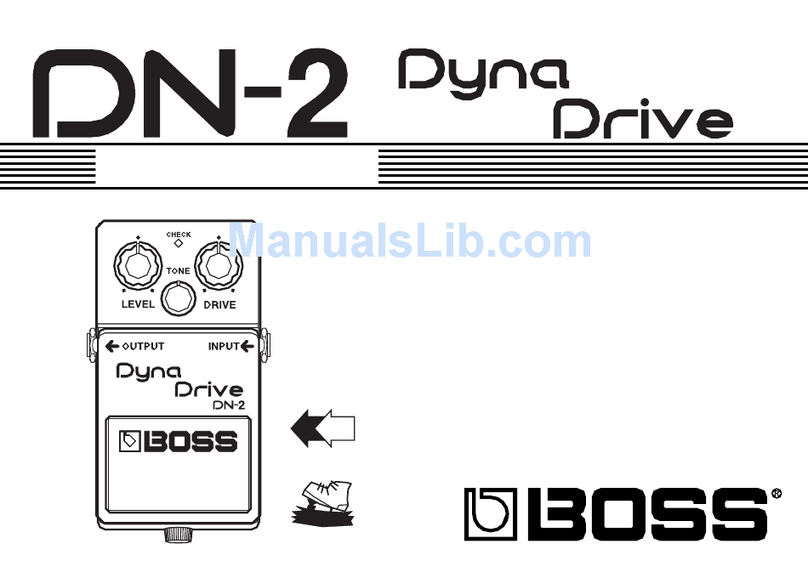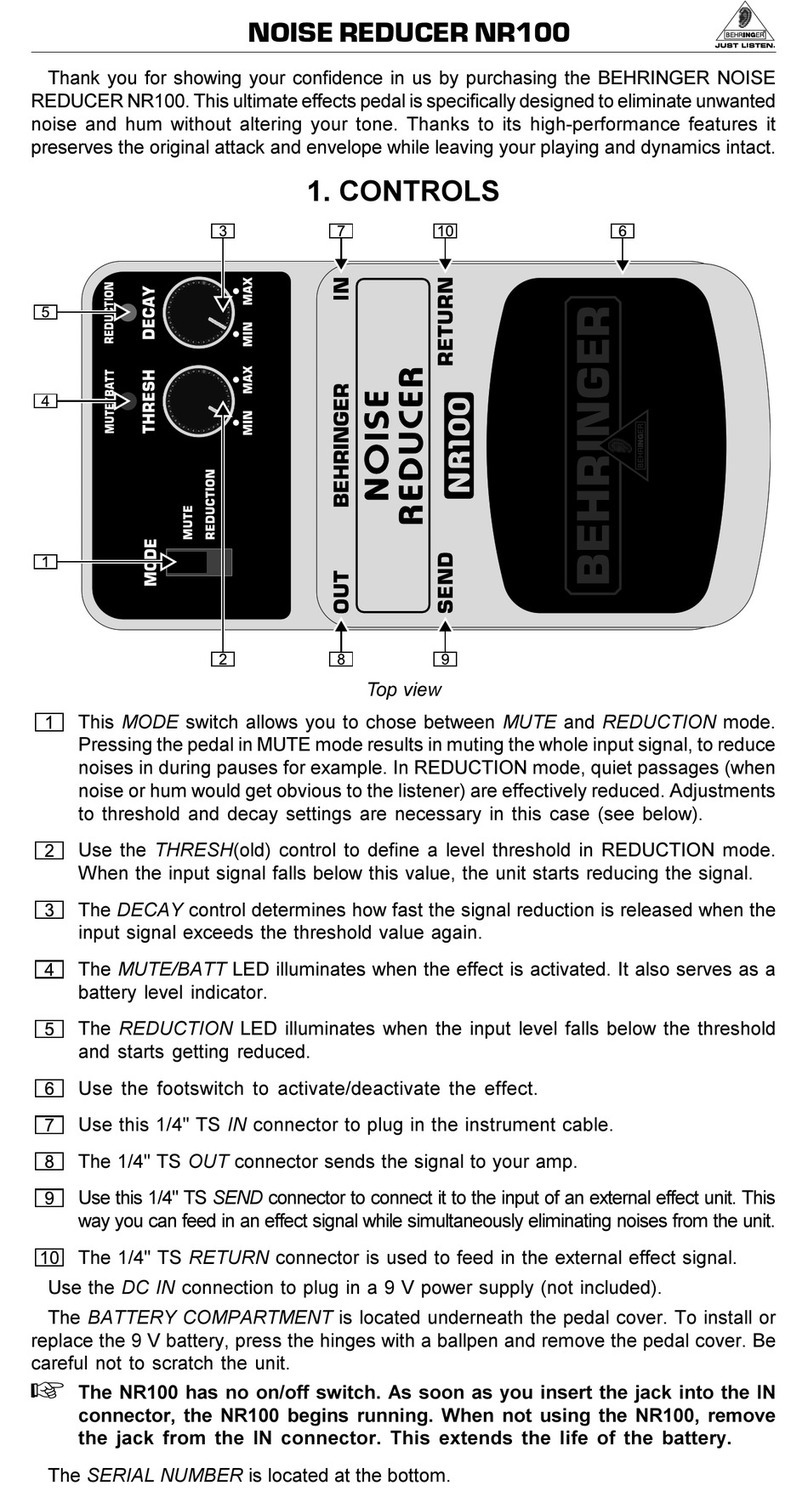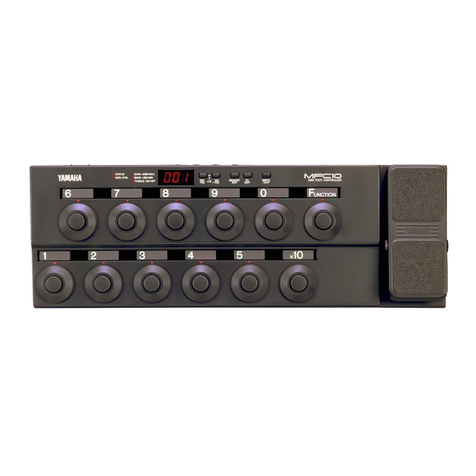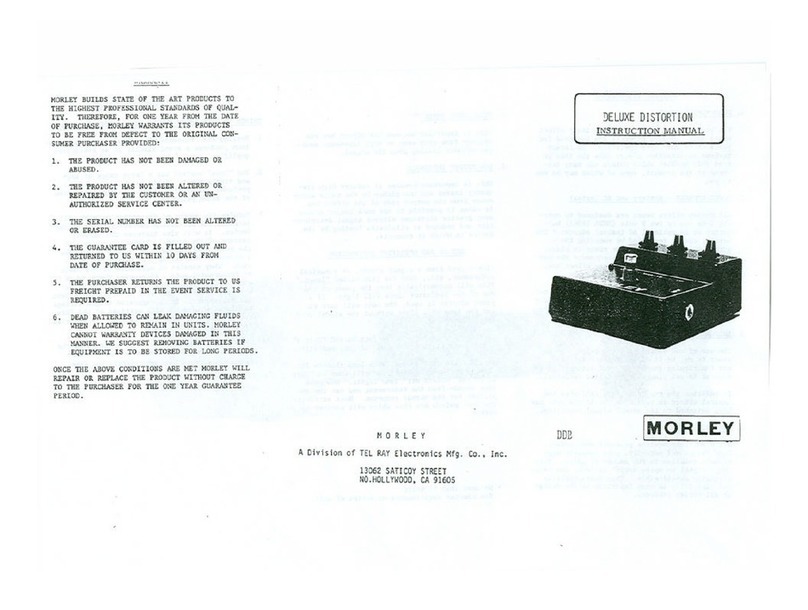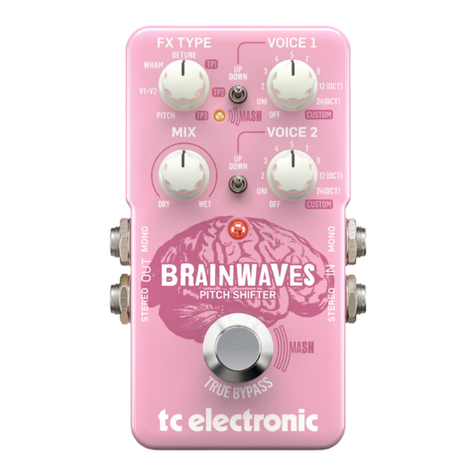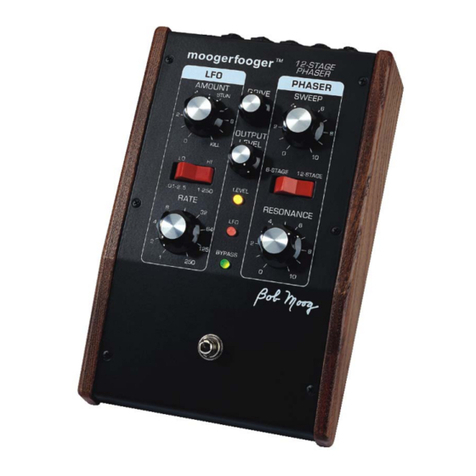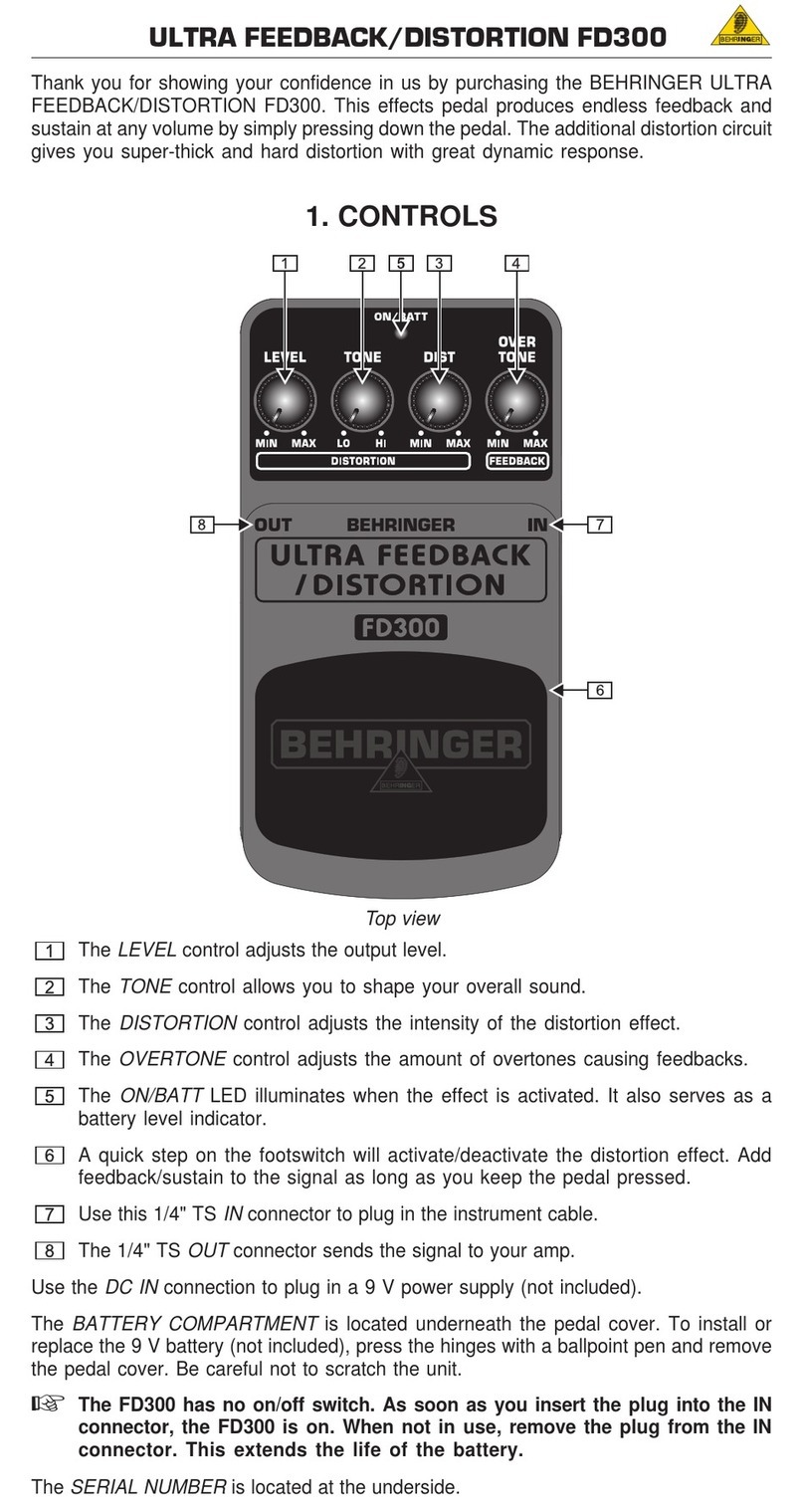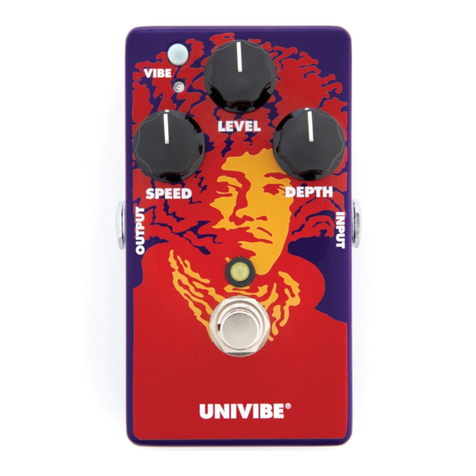BOSSCO Space Echo RE-202 User manual

RE-202
Reference Manual

Table of contents
2
Table of contents
Panel Descriptions ..................................................................3
Top Panel ............................................................................... 3
Rear Panel .............................................................................. 5
Connecting External Pedals ................................................. 6
Turning the power on/off ..................................................... 7
Head Combinations for Each Mode ..................................... 8
Saving and Switching Between Memories.....................9
Various Settings .................................................................... 10
Setting the Expression Pedal Function.............................. 10
Setting the Footswitch Functions (CTL 1 FUNCTION, CTL 2
FUNCTION)........................................................................... 11
Turning the Direct Sound Output On/Off (DIRECT ON/OFF)
.............................................................................................. 12
Switching Between Direct Sounds (DIRECT MODE) .......... 13
Preserving/Muting the Tail of an Effect when the Effect is
Switched Off (CARRYOVER)................................................ 14
Setting the Operation Mode for the [REPEAT RATE] Knob
(TIME MODE)........................................................................ 15
Switching Between Reverb Types (REVERB TYPE) ............ 16
Setting the Maximum Value of MEMORY (MEMORY
EXTENT) ............................................................................... 17
MIDI Settings ....................................................................... 18
Restoring the Factory Default Settings (Factory Reset)
.................................................................................................... 21
Attaching the Rubber Feet................................................ 22
Main Specifications.............................................................. 23

Panel Descriptions
3
Panel Descriptions
Top Panel
Name
Function
1
[MEMORY]
button
Switches between or saves memories (MANUAL, 1–4). The currently selected memory number is shown by
the MANUAL and MEMORY 1–4 indicators. When using an external MIDI device to select memories 5–127,
the indicators all remain dark.
2
[INPUT] button
Use this to select the device that’s connected to INPUT.
GUITAR: Use this when connecting a guitar or bass guitar.
LINE: Use this when connecting a synthesizer, mixer or similar equipment.
*These are system settings, which apply to all memories.
*Long-press the [INPUT] button to configure the expression pedal function.
3
[TAPE] button
Switches between the sounds of new tape and tape that’s been somewhat used. The tone and wavering of
the sound change.
*By long-pressing the [TAPE] button, you can switch between enabling (unlocking) or disabling
(locking) the knobs and buttons. If you attempt an operation while the unit is locked, the display
blinks.
4
[SATURATION]
knob
Adjusts the compressed feel, which is caused by preamp distortion and the magnetic saturation of the
tape.
5
[WOW &
FLUTTER] knob
Adjusts the wavering in tape speed, which occurs due to the friction resistance of the tape mechanism,
tape slippage and so on.
Turning this clockwise produces more wavering.
6
[MODE
SELECTOR] knob
Switches between modes 1–12. The combination of four different playback heads gives you 12 types of
echo.
1.5. Head Combinations for Each Mode(P.8)
7
[BASS] knob
Adjusts the echo’s low frequency range.
8
[TREBLE] knob
Adjusts the echo’s high frequency range.
9
[REVERB VOL]
knob
Adjusts the volume of the reverb. If the [ECHO VOL] knob is turned all the way counterclockwise, you can
use only reverb.

Panel Descriptions
4
Name
Function
10
[REPEAT RATE]
knob
Adjusts the tape speed. The farther the knob is turned clockwise, the shorter the intervals become
between echoes. The tone also changes along with the speed.
11
[INTENSITY]
knob
Adjusts the echo volume (amount of feedback). Turn this all the way clockwise to make the effect oscillate.
12
[ECHO VOL]
knob
Adjusts the echo volume.
13
[ON/OFF] switch
Press to turn the effect on/off.
Long-press (WARP) to create stronger reverberations the longer you press, producing a dreamlike sound.
14
[MEMORY]
switch
Press to switch between memories.
Long-press to select whether reverb is used simultaneously with echo or not.
15
[TAP] switch
Press to set the REPEAT RATE according to the tempo of the song being played.
Long-press (TWIST) to produce an aggressive sense of rotation that oscillates the echoed sound while you
press.

Panel Descriptions
5
Rear Panel
Name
Function
16
INPUT A/MONO,
B
Connect your electric guitar, keyboard, or other musical instruments and effect units to these input jacks.
For mono output, connect to the A/MONO jack.
17
OUTPUT
A/MONO, B
Connect your guitar amp, keyboard amp, other effect units or your mixer here.
When connected to both the A/MONO and B jacks, the reverb effect is heard in stereo if you apply this
effect.
For mono output, connect to the A/MONO jack.
18
CTL 1, 2/EXP jack
●
Using as the CTL 1, 2 jack
You can connect a footswitch (FS-5U, FS-6, FS-7; sold separately) to switch between TWIST and WARP effects,
switch memories up/down and so on.
●Using as the EXP jack
Connect an expression pedal (such as the EV-30 or Roland EV-5; sold separately) to continuously change the
effect settings for the expression pedal’s pushed-up (horizontal) position and for the pushed-down (slanted)
position.
19
MIDI IN/OUT
connectors
Use TRS/MIDI connecting cables (BMIDI-5-35, BMIDI-1-35, BCC-1-3535; sold separately) to connect this
unit to an external MIDI device.
You can use an external MIDI device to switch between up to 127 memories on this unit.
*Do not use these connectors for connecting to audio devices. Doing so may cause a malfunction.
20
USB port
Connect your computer using a commercially available USB cable that supports USB 2.0.
*Do not use a micro USB cable that is designed only for charging a device. Charge-only cables cannot
transmit data.
*Used only for updating programs.
21
DC IN jack
Connect the AC adaptor to this jack.
*Use only the specified AC adaptor (PSA-series), connected to a 100 V AC power source.
*When you connect the included AC adaptor to the DC IN jack, the unit turns on.
1.4. Turning the power on/off(P.7)
22
Ground terminal
Connect this to an external earth or ground. This should be connected when necessary.
*To prevent malfunction and equipment failure, always turn down the volume, and turn off all the units before making any
connections.

Panel Descriptions
6
Connecting External Pedals

Panel Descriptions
7
Turning the power on/off
Once everything is properly connected, be sure to follow the procedure below to turn on their power. If you turn on equipment in
the wrong order, you risk causing malfunction or equipment failure.
Turning the Power On
Turn on the power to your amp last.
Turning the Power Off
Turn off the power to your amp first.
*Before turning the unit on/off, always be sure to turn the volume down. Even with the volume turned down, you might hear
some sound when switching the unit on/off. However, this is normal and does not indicate a malfunction.

Panel Descriptions
8
Head Combinations for Each Mode
MODE
1
2
3
4
5
6
7
8
9
10
11
12
Playback head 1
Á
Á
Á
Á
Á
Á
Á
Á
Playback head 2
Á
Á
Á
Á
Á
Á
Playback head 3
Á
Á
Á
Á
Á
Á
Á
Playback head 4
Á
Á
Á
Á
Á
*The delay times for playback heads 2, 3 and 4 are 2x, 3x and 4x the delay time of playback head 1 respectively. When you use
tap input, this is set as the delay time (tap delay time) for playback head 1, which is the base delay time for each mode.
*Modes 8–12 feature the sound of playback head 4, which was not on the Roland Space Echo RE-201.
*MODE 12 differs from the other modes, in that the positions of the four playback heads are optimized to create a highly
dense sound.

Saving and Switching Between Memories
9
Saving and Switching Between Memories
Saving to a Memory
You can save the settings you’ve edited.
1.
Long-press the [MEMORY] button.
The indicator of the currently selected memory number blinks, and the memory enters write standby mode.
2.
Take your finger off the [MEMORY] button.
3.
Press the [MEMORY] button to select where to save the memory.
Each time you press the button, the memory selector cycles through as follows: MANUALÓ1Ó2Ó3Ó4.
You can use an external MIDI device to select memories 5–127. When you select memories 5–127, the MEMORY 1–4 indicators
all blink.
4.
Long-press the [MEMORY] button once more to save.
The memory number indicators blink rapidly. Once they remain lit, the write operation is finished.
When using an external MIDI device to select memories 5–127, the MEMORY 1–4 indicators all blink rapidly and then go dark.
*If you operate the knobs or footswitch before step 3, the write operation is canceled.
*If you’ve saved to MANUAL, only the [TAPE] button and expression pedal settings are saved.
Switching Memories
Here’s how to recall a saved memory.
1.
Press the [MEMORY] button or [MEMORY] switch to select the memory.
Each time you press the button/switch, the memory selector cycles through as follows: MANUALÓ1Ó2Ó3Ó4.
You can use an external MIDI device to select memories 5–127 via MIDI. When you select memories 5–127, the MEMORY 1–4
indicators all go dark.
What is “MANUAL”?
Normally, effects are applied according to the settings in memory. However, when you select MANUAL, effects are applied
according to the position of the knobs on the panel. At this time, the [TAPE] button and expression pedal settings that are recalled
are those saved in MANUAL (which are editable).

Various Settings
10
Various Settings
Setting the Expression Pedal Function
By connecting an expression pedal (such as the Roland EV-5, sold separately) to the CTL 1, 2/EXP jack, you can operate the top
panel knobs except for the [MODE SELECTOR] knob.
You can set the respective sounds for when the expression pedal is at MAX position (pushed all the way up with your toes) and at
MIN position (pushed all the way down with your heel), and make continuous changes to them.
*Use only the specified expression pedal. Connecting expression pedals made by third-party manufacturers may cause this
unit to malfunction.
You can use different expression pedal settings for MANUAL and for each memory in MEMORY 1–4 respectively.
1.
Use the [MEMORY] button to select the memory (MANUAL, MEMORY 1–4) for which you want to
configure the expression pedal.
2.
Long-press the [INPUT] button.
The GUITAR indicator blinks.
3.
Use the respective knobs to set the sound that’s used when the pedal is at the MIN value (pushed all the
way down with your heel).
4.
Press the [INPUT] button again.
The LINE indicator blinks.
5.
Use the respective knobs to set the sound that’s used when the pedal is at the MAX value (pushed all the
way up with your toes).
6.
Press the [INPUT] button again to exit the function settings.

Various Settings
11
Setting the Footswitch Functions (CTL 1 FUNCTION, CTL 2 FUNCTION)
Here’s how to configure the functions of the footswitch connected to the CTL 1, 2/EXP jack (FS-5U, FS-6, FS-7; sold separately).
1.
Press and hold down the [TAP] switch, and turn on the power.
2.
Set the [MODE SELECTOR] knob to “6” if you wish to set the CTL 1 function, or to “7” if you wish to set
the CTL 2 function.
3.
Use the [MEMORY] button to select the function to set.
MEMORY indicators
Function
MANUAL
Select the next memory.
1
Select the previous memory.
2
Turn on/off effects.
3
Press the footswitch at the tempo of the song you’re playing to specify a matching repeat rate.
4
CTL 1: WARP is on while the switch is pressed.
CTL 2: TWIST is on while the switch is pressed.
4.
Press the [TAP] switch to exit the function settings.

Various Settings
12
Turning the Direct Sound Output On/Off (DIRECT ON/OFF)
You can turn the output of the direct sound off when you want to output only the effect’s sound, such as when you’re connecting
this unit to the send/return of a mixer.
1.
Press and hold down the [TAP] switch, and turn on the power.
2.
Turn the [MODE SELECTOR] knob to the “8” setting.
3.
Select on or off with the [MEMORY] button.
MEMORY indicators
Function
MANUAL
Outputs the direct sound.
1
Does not output the direct sound.
4.
Press the [TAP] switch to exit the settings.

Various Settings
13
Switching Between Direct Sounds (DIRECT MODE)
1.
Press and hold down the [TAP] switch, and turn on the power.
2.
Turn the [MODE SELECTOR] knob to the “9” setting.
Use the [MEMORY] button to select a sound.
MEMORY
indicators
Function Explanation
MANUAL
Analog Bypass
The audio input is outputted without change.
1
RE-201 Simulation
Uses digital signal processing to recreate the sound of the direct sound going
through a RE-201 preamp.
3.
Press the [TAP] switch to exit the settings.
*When this is set to “RE-201 Simulation,” the simulation effect is still heard even when the effect is off.
*When this is set to “RE-201 Simulation,” the effect of the [SATURATION] knob when the effect is on adds preamp distortion to
both the echo sound and the direct sound at the same time.

Various Settings
14
Preserving/Muting the Tail of an Effect when the Effect is Switched Off
(CARRYOVER)
This sets whether to preserve (carry over) the tail of an effect after the effect is switched off or when switching to a different
memory.
1.
Press and hold down the [TAP] switch, and turn on the power.
2.
Turn the [MODE SELECTOR] knob to the “10” setting.
3.
Use the [MEMORY] button to select the setting.
MEMORY indicators
Function
MANUAL
Reverberation carries over
1
Reverberation does not carry over
4.
Press the [TAP] switch to exit the settings.

Various Settings
15
Setting the Operation Mode for the [REPEAT RATE] Knob (TIME MODE)
You can switch the operating mode of the [REPEAT RATE] knob to change the tape speed’s adjustable range. The setting range for
the tap delay time (delay time for playback head 1) also changes at the same time.
1.
Press and hold down the [TAP] switch, and turn on the power.
2.
Turn the [MODE SELECTOR] knob to the “11” setting.
3.
Use the [MEMORY] button to select the mode.
MEMORY indicators
Mode
Function
MANUAL
Normal
The [REPEAT RATE] knob operates in the same range as the Roland RE-201.
The value for the tap delay time can be set to a maximum of one second.
1
Long
The setting range for the [REPEAT RATE] knob is twice that of Normal mode.
The value for the tap delay time can be set to a maximum of two seconds.
4.
Press the [TAP] switch to exit the settings.

Various Settings
16
Switching Between Reverb Types (REVERB TYPE)
1.
Press and hold down the [TAP] switch, and turn on the power.
2.
Turn the [MODE SELECTOR] knob to the “12” setting.
3.
Use the [MEMORY] button to select the reverb type.
MEMORY indicators
Reverb type
MANUAL
RE-201 SPRING
1
HALL
2
PLATE
3
ROOM
4
AMBIENCE
4.
Press the [TAP] switch to exit the settings.

Various Settings
17
Setting the Maximum Value of MEMORY (MEMORY EXTENT)
Here’s how to set the maximum value for the selectable memories.
1.
Press and hold down the [TAP] switch, and turn on the power.
2.
Turn the [MODE SELECTOR] knob to the “1” setting.
3.
Use the [MEMORY] button to set the maximum value.
MEMORY indicators
Maximum Value
1
1
2
2
3
3
4
4
4.
Press the [TAP] switch to exit the settings.

Various Settings
18
MIDI Settings
1.
Press and hold down the [ON/OFF] switch, and turn on the power.
2.
Turn the [MODE SELECTOR] knob to select the parameter to set.
3.
Use the [MEMORY] button to select the setting.
4.
Press the [ON/OFF] switch to exit the settings.
Setting
[MODE
SELECTOR]
knob
Value Indicators
that are lit Explanation
Receive channel
(RX CH)
6
OFF
MEMORY:
MANUAL,
HEAD: 1
Off
1
MEMORY: 1,
HEAD: 1
CH. 1
2
MEMORY: 2,
HEAD: 1
CH. 2
3
MEMORY: 3,
HEAD: 1
CH. 3
4
MEMORY: 4,
HEAD: 1
CH. 4
5
MEMORY:
MANUAL,
HEAD: 2
CH. 5
6
MEMORY: 1,
HEAD: 2
CH. 6
7
MEMORY: 2,
HEAD: 2
CH. 7
8
MEMORY: 3,
HEAD: 2
CH. 8
9
MEMORY: 4,
HEAD: 2
CH. 9
10
MEMORY:
MANUAL,
HEAD: 3
CH. 10
11
MEMORY: 1,
HEAD: 3
CH. 11
12
MEMORY: 2,
HEAD: 3
CH. 12
13
MEMORY: 3,
HEAD: 3
CH. 13
14
MEMORY: 4,
HEAD: 3
CH. 14
15
MEMORY:
MANUAL,
HEAD: 4
CH. 15
16
MEMORY: 1,
HEAD: 4
CH. 16
Transmit channel
(TX CH)
7
OFF
MEMORY:
MANUAL,
HEAD: 1
Off
1
MEMORY: 1,
HEAD: 1
CH. 1
2
MEMORY: 2,
HEAD: 1
CH. 2
3
MEMORY: 3,
HEAD: 1
CH. 3
4
MEMORY: 4,
HEAD: 1
CH. 4
5
MEMORY:
MANUAL,
HEAD: 2
CH. 5
6
MEMORY: 1,
HEAD: 2
CH. 6

Various Settings
19
Setting
[MODE
SELECTOR]
knob
Value Indicators
that are lit Explanation
7
MEMORY: 2,
HEAD: 2
CH. 7
8
MEMORY: 3,
HEAD: 2
CH. 8
9
MEMORY: 4,
HEAD: 2
CH. 9
10
MEMORY:
MANUAL,
HEAD: 3
CH. 10
11
MEMORY: 1,
HEAD: 3
CH. 11
12
MEMORY: 2,
HEAD: 3
CH. 12
13
MEMORY: 3,
HEAD: 3
CH. 13
14
MEMORY: 4,
HEAD: 3
CH. 14
15
MEMORY:
MANUAL,
HEAD: 4
CH. 15
16
MEMORY: 1,
HEAD: 4
CH. 16
RX
MEMORY: 2,
HEAD: 4
Transmits on the same channel as the RX CHANNEL.
Receive program
change message
(PC IN)
8
ON
MEMORY:
MANUAL
Program change messages are received.
OFF
MEMORY: 1
Program change messages are not received.
Transmit program
change messages
(PC OUT)
9
ON
MEMORY:
MANUAL
Program change messages are transmitted.
OFF
MEMORY: 1
Program change messages are not transmitted.
Receiving control
change message
(CC IN)
10
ON
MEMORY:
MANUAL
Control change messages are received.
OFF
MEMORY: 1
Control change messages are not received.
Transmit control
change messages
(CC OUT)
11
ON
MEMORY:
MANUAL
Control change messages are transmitted.
OFF
MEMORY: 1
Control change messages are not transmitted.
MIDI clock sync
(SYNC)
12
INTERNAL
MEMORY:
MANUAL
Operations are synchronized to the RE-202’s internal
clock.
AUTO
MEMORY: 1
Operations are synchronized to the MIDI clock received
via MIDI. However, operations are automatically
synchronized to the RE-202’s internal clock if the unit is
unable to receive the external clock.
REALTIME
SOURCE
1
INTERNAL
MEMORY:
MANUAL
Internal real-time messages are used as the clock source.
MIDI
MEMORY: 1
Real-time messages from the MIDI IN connector are used
as the clock source.
MIDI THRU
2
ON
MEMORY:
MANUAL
Specifies whether MIDI messages received at the MIDI IN
connector are retransmitted as-is from the MIDI OUT
connector (ON) or are not retransmitted (OFF).
OFF
MEMORY: 1
DEVICE ID
3
17
MEMORY:
MANUAL,
HEAD: 1
This sets the MIDI Device ID used for transmitting and
receiving Exclusive messages.
18
MEMORY: 1,
HEAD: 1
19
MEMORY: 2,
HEAD: 1
20
MEMORY: 3,
HEAD: 1
21
MEMORY: 4,
HEAD: 1
22
MEMORY:
MANUAL,
HEAD: 2

Various Settings
20
Setting
[MODE
SELECTOR]
knob
Value Indicators
that are lit Explanation
23
MEMORY: 1,
HEAD: 2
24
MEMORY: 2,
HEAD: 2
25
MEMORY: 3,
HEAD: 2
26
MEMORY: 4,
HEAD: 2
27
MEMORY:
MANUAL,
HEAD: 3
28
MEMORY: 1,
HEAD: 3
29
MEMORY: 2,
HEAD: 3
30
MEMORY: 3,
HEAD: 3
31
MEMORY: 4,
HEAD: 3
32
MEMORY:
MANUAL,
HEAD: 4
Table of contents
Other BOSSCO Music Pedal manuals
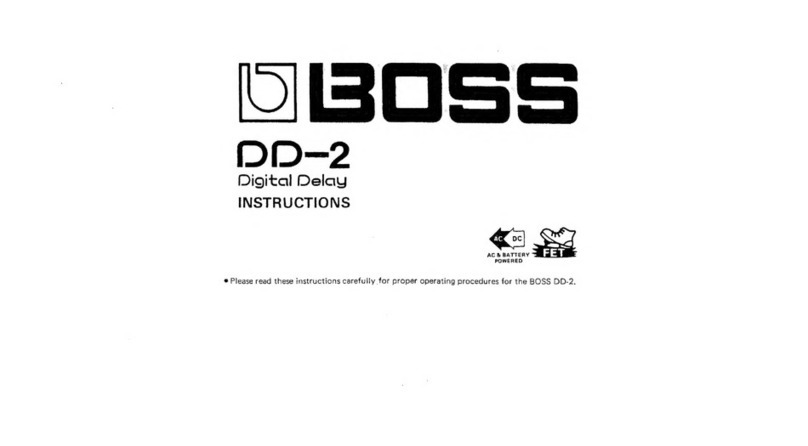
BOSSCO
BOSSCO DD-2 User manual
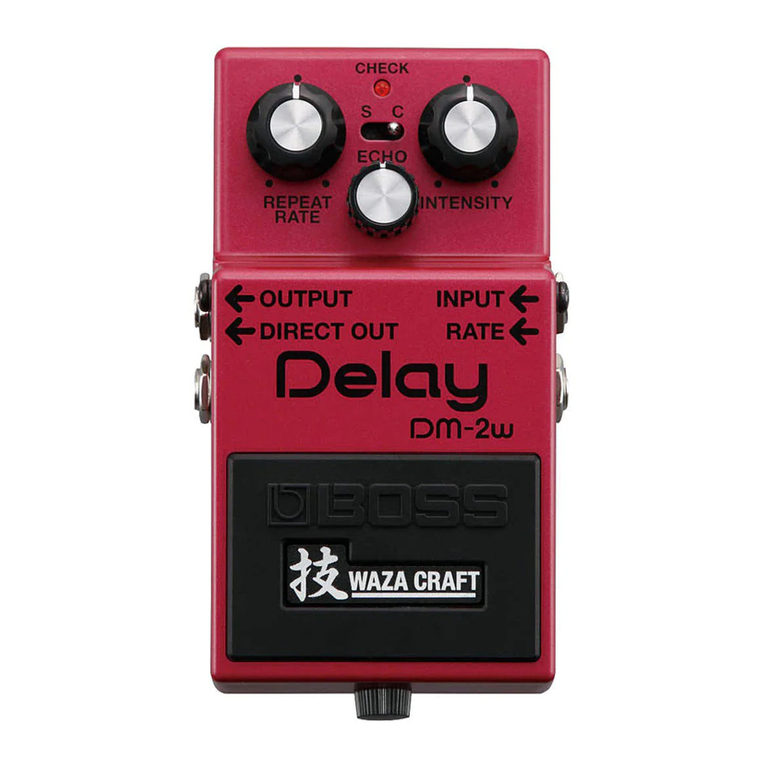
BOSSCO
BOSSCO WAZA CRAFT Delay User manual

BOSSCO
BOSSCO IR-200 User manual
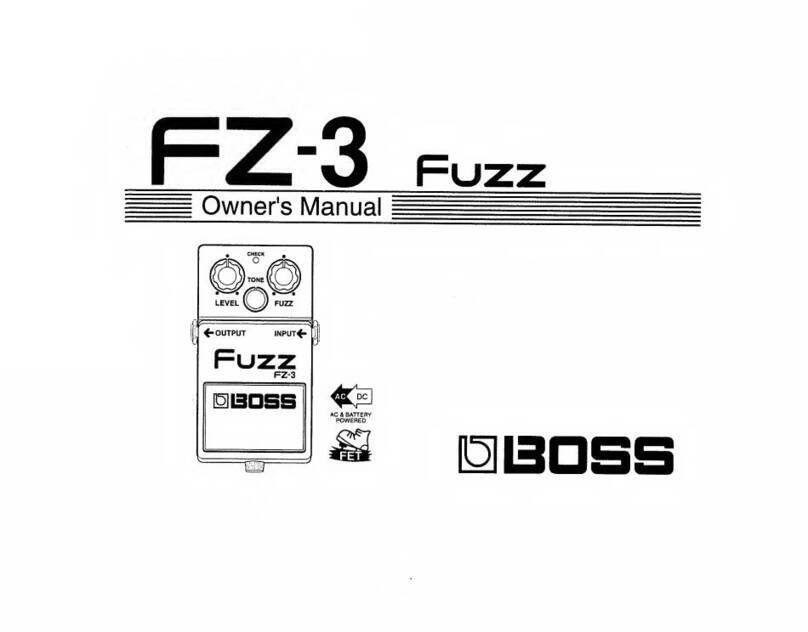
BOSSCO
BOSSCO Fuzz FZ-3 User manual
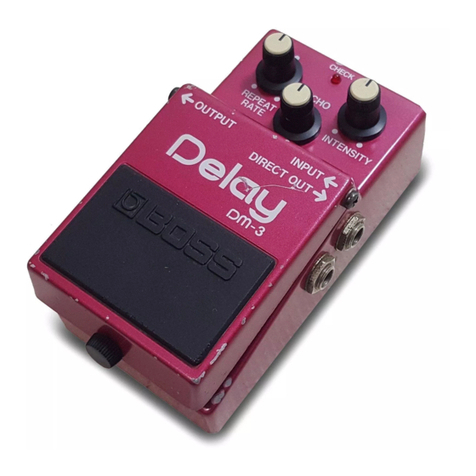
BOSSCO
BOSSCO DM-3 Delay User manual
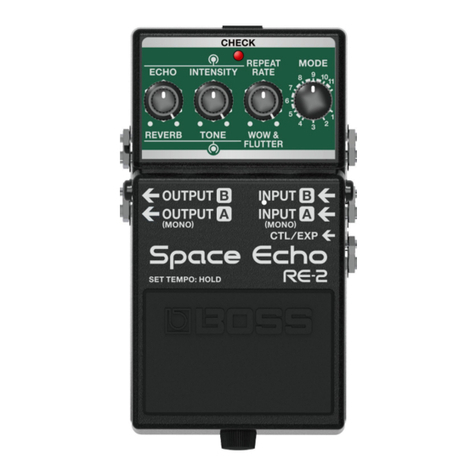
BOSSCO
BOSSCO RE-2 User manual

BOSSCO
BOSSCO DF-2 User manual
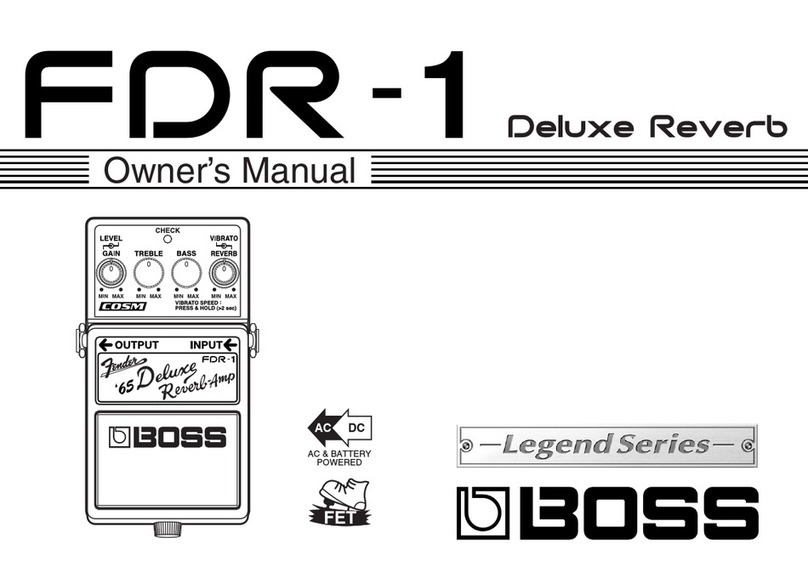
BOSSCO
BOSSCO FDR-1 Deluxe Reverb User manual

BOSSCO
BOSSCO ME-10 User manual
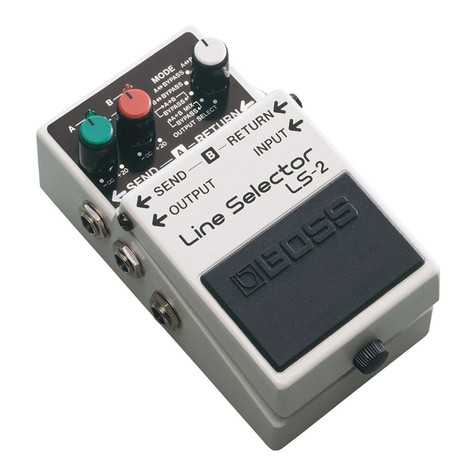
BOSSCO
BOSSCO LS-2 User manual

BOSSCO
BOSSCO CE-2 Chorus User manual

BOSSCO
BOSSCO Metal Zone MT-2 User manual
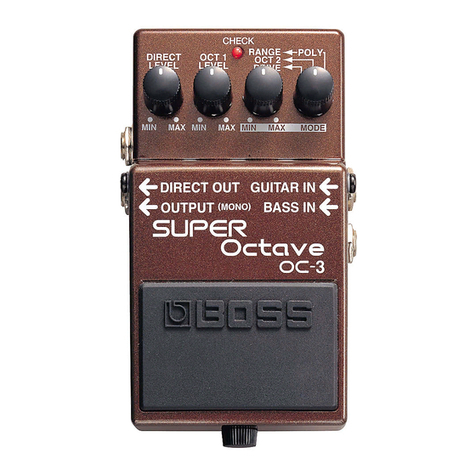
BOSSCO
BOSSCO OC-3 Super Octave User manual

BOSSCO
BOSSCO ME-8B User manual
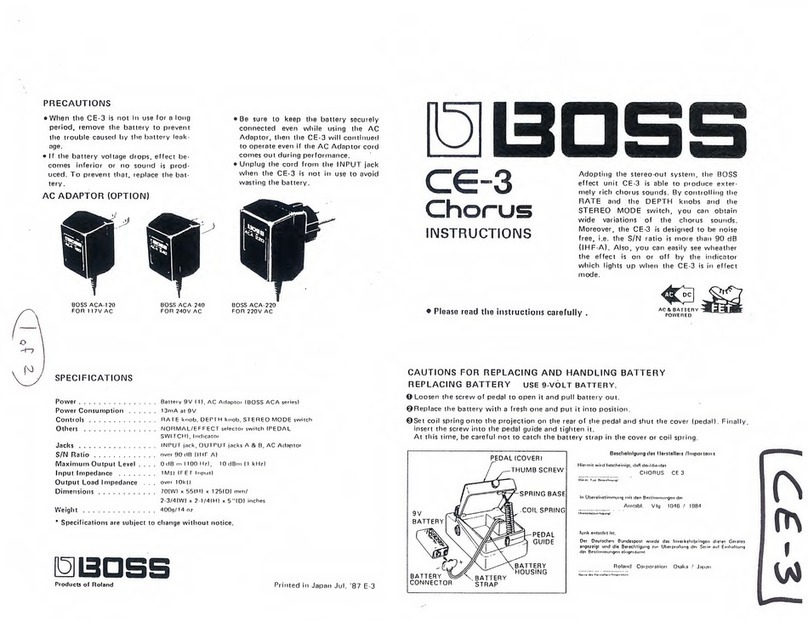
BOSSCO
BOSSCO Chorus CE-3 User manual
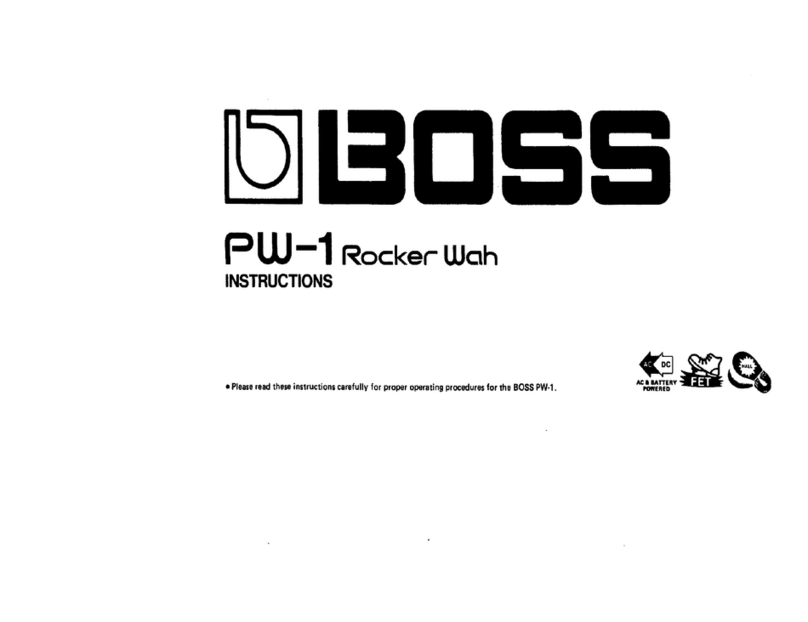
BOSSCO
BOSSCO Boss PW-1 User manual

BOSSCO
BOSSCO PH-3 Phase Shifter User manual

BOSSCO
BOSSCO BCB-60 User manual

BOSSCO
BOSSCO CS-3 User manual

BOSSCO
BOSSCO FW-3 Foot Wah User manual



